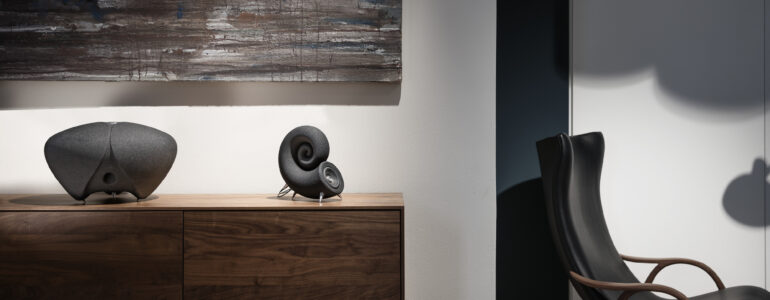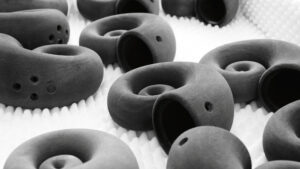10/03/22

How a small startup in Czechia is challenging the giants of the audio industry with the help of 3D printing
It started, as many creative revolutions do, with a problem. “I’m a designer, a creative,” says Ondrej Chotovinsky, Founder of Deeptime Audio, “so I spend a lot of time working at my desk listening to music.” There are a few items you will find on every creative’s desk: a computer, a large monitor, and speakers. The problem, however, was that music fans faced a choice. Standard PC speakers are compact but generally have poor sound performance. On the other hand, professional sound equipment like studio sound monitors are large and expensive. And neither of these options offer the visual appeal of something designers want to have on their desk.
Deeptime sound system with subwoofer and speaker
This was the start of an eight-year quest for the perfect speakers, made possible by an innovation that is revolutionizing the creative industry: 3D printing. Traditionally, manufacturing a hardware prototype was a significant investment – and even after the prototyping phase, the process of updating and upgrading designs was held back by the need to produce in bulk to justify the cost of creating hard tooling or patterns. All of that changes with 3D printing, where a digital design can be turned into a unique piece of bonded sand. Semi-finished products like the printed form of a speaker can be delivered in under a week without any tooling. Through the power of mass customization, every new order can be an upgrade and the minimum order size is one. But there are a number of different technologies on the 3D printing market, and finding the right process and material for each use case can be tricky.
“We looked at manufacturing the base units with other 3D sand printing suppliers on the market, but no one could match ExOne, from day one.”
Ondrej Chotovinsky, Founder of Deeptime
“We started with 3D printing in plastics,” says Chotovinsky. “They looked fantastic, but the sound wasn’t that great.” It’s a logical place to start – 3D printed plastic can be used to build more interesting shapes, but the material is light and not particularly rigid. This is a problem for sound quality since an unstable speaker cabinet will cause adverse resonances. The plastic 3D printing options were also too expensive for this application. The breakthrough came at a trade fair in Birmingham, where Chotovinsky discovered 3D sand printing at the ExOne stand.
ExOne is a global leader in binder jet additive manufacturing, providing industrial 3D printing systems and services. Their binder jetting process quickly and inexpensively prints objects from a combination of sand and adhesive, most commonly in the metalcasting industry as part of the metal moldmaking process. The generative 3D printing process shapes layer-by-layer without supporting structures, allowing maximum design freedom which is reflected in the unique shape of the Deeptime speakers. The prints this method produces are heavy and stiff, but porous, which is not ideal for acoustic applications. Speaker cases need to be airtight, to produce a clean sound free from distortion, so further processing would be necessary to the sand forms.

Sand 3D printed raw housing (left) and assembling the speaker (right)
After years of experimentation Deeptime had found the perfect solution. Now, the raw housing is printed at the ExOne Adoption Center in Germany and shipped to the Deeptime facility just outside Prague, arriving seven days later. ExOne Adoption Centers are not only on hand to develop sandcasting molds and cores to support customers’ businesses, they also provide in-depth advice ensuring the desired quality and properties are met. “We looked at manufacturing the base units with other 3D sand printing suppliers on the market,” says Chotovinsky, “but no one could match ExOne, from day one. In terms of quality and quick turnaround, as well as warranty and professional services, no-one came close.”
A two-year study conducted at the Brno University of Technology verified the acoustic properties of the finished material.
In the course of the manufacturing process the prints are cleaned and repeatedly dipped in a proprietary solution that impregnates the porous sand structure. A slow curing process over two months ensures that the material hardens and the housing is airtight and dense. The outstanding sound properties of the final products exceeded even the high expectations of the developers – and could be scientifically proven. A two-year study conducted at the Brno University of Technology verified the acoustic properties of the finished material; the sand structure manufactured on ExOne 3D printers is 86 % more rigid than MDF, leading to double the sound damping inside the unit compared to a more traditional speaker.
The spiral design of the finished Deeptime Spirula satellite speaker mirrors the organic shapes found in nature – the curve of a sea-shell or the proportions of an uncurling fern leaf. It’s an expression of what is known as the golden ratio, a proportion first noticed in nature by the ancient Greeks. This type of freeform, precise construction is made possible by additive 3D printing that builds the structure, one layer of sand at a time. But the design isn’t just about aesthetics. Chotovinsky’s day job is in the automotive industry and the tolerances of the speaker’s shape are designed with an engineer’s precision in auto-industry CAD software. The volume of the resonant chamber is tuned to the speed of sound in air to optimize acoustic performance. The Thunderstone subwoofer that completes the set is built with similar attention to both design and build quality and produces a surprising volume and richness of tone for such a small unit.
Spiral design inspired by shapes found in nature is an expression of the golden ratio (left)
Cross section of the Spirula speaker (right)
American artist Jean-Michel Basquiat said it best: “Art is how we decorate space, music is how we decorate time.” Deeptime speakers do both. They are a perfect example of new technology liberating the creative process and of how collaborations between innovative companies, like ExOne and Deeptime as exclusive partners for this groundbreaking sound project, continue to push the boundaries of manufacturing and its intersection with design.
Article from our partner ExOne